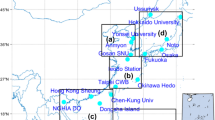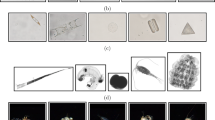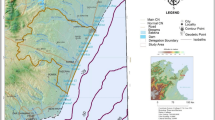Abstract
It is known that the structure of benthic macrophyte and invertebrate habitats indicate the quality of coastal water. Thus, a large-scale analysis of the spatial patterns of coastal marine habitats makes it possible to adequately estimate the status of valuable coastal marine habitats, provide better evidence for environmental changes, and describe the processes behind the changes. Knowing the spatial distribution of benthic habitats is also important from the coastal management point of view. Our previous results clearly demonstrated that remote sensing methods can be used to map water depth and distribution of taxonomic groups of benthic algae (e.g., red, green, and brown algae) in the optically complex coastal waters of the Baltic Sea. We have as well shown that benthic habitat mapping should be done at high spatial resolution owing to the small-scale heterogeneity of such habitats in Estonian coastal waters. Here we tested the capability of high spatial resolution hyperspectral airborne image in its application for mapping benthic habitats.
A big challenge is to define appropriate mapping classes that are also meaningful from the ecological point of view. In this study two benthic habitat classification schemes—broader level and finer level—were defined for the study area. The broader level classes were relatively well classified, but discrimination among the units of the finer classification scheme posed a considerable challenge and required a careful approach. Benthic habitat classification provided the highest accuracy in the case of the Spectral Angle Mapper classification method applied to a radiometrically corrected image. Further processing levels, such as spatial filtering and glint correction, decreased the classification accuracy.
Similar content being viewed by others
References
E. P. Green, P. J. Mumby, A. J. Edwards, and C. D. Clark, Remote Sensing Handbook for Tropical Coastal Management, Coastal Management Sourcebooks 3 (UNESCO, Paris, 2000).
J. D. Hedley, A.R. Harborne, and P.J. Mumby, “Simple and Robust Removal of Sun Glint for Mapping Shallow-Water Benthos,” Int. J. Remote Sensing 26(10), 2107–2112 (2005).
K. Herkül, J. Kotta, and M. Pärnoja, “Effect of Physical Disturbance on the Soft Sediment Benthic Macrophyte and Invertebrate Community in the Northern Baltic Sea,” Boreal Environmental Research 16, 209–219 (2011).
J. Kotta, R. Aps, and H. Orav-Kotta, “Bayesian Inference for Predicting Ecological Water Quality under Different Climate Change Scenarios,” Management of Natural Resources, Sustainable Development and Hazards II 127, 173–184 (2009).
J. Kotta, A. Jaanus, and I. Kotta, “Haapsalu and Matsalu Bay, in Ecology of Baltic Coastal Waters,” in Ecological Studies (Springer, 2008), pp. 245–258.
T. Kutser, M. Hiire, L. Metsamaa, E. Vahtmäe, P. Paavel, and R. Aps, “Field Measurements of Spectral Backscattering Coefficient of the Baltic Sea and Boreal Lakes,” Boreal Environmental Research 14(2), 305–312 (2009b).
T. Kutser, L. Metsamaa, N. Strömbeck, and E. Vahtmäe, “Monitoring Cyanobacterial Blooms by Satellite Remote Sensing,” Estuarine Coastal Shelf Sci. 67(1–2), pp. 303–312 (2006a).
T. Kutser, L. Metsamaa, E. Vahtmäe, and R. Aps, “Operative Monitoring of the Extent of Dredging in Coastal Ecosystems Using MODIS Satellite Imagery,” J. Coast. Res. SI50, 180–1884 (2007).
T. Kutser, B. Paavel, Metsamaa, L., and E. Vahtmäe, “Mapping Coloured Dissolved Organic Matter Concentration in Coastal Waters,” International Journal of Remote Sensing 30(22), 5843–5849 (2009a).
T. Kutser, E. Vahtmäe, and G. Martin, “Assessing Suitability of Multispectral Satellites for Mapping Benthicmacroalgal Cover in Turbid Coastal Waters by Means of Model Simulations,” Estuarine Coastal Shelf Sci. 67(3), 521–529 (2006b).
T. M. Lillesand, R. W. Kiefer, and J. W. Chipman, Remote Sensing and Image Interpretation (John Wiley & Sons, USA, 2007).
T. Möller, J. Kotta, and G. Martin, “Effect of Observation Method on the Perception of Community Structure and Water Quality in a Brackish Water Ecosystem,” Marine Ecology, 30, Suppl. 1, 105–112 (2009).
Remote Sensing of Aquatic Coastal Ecosystem Processes Ed. by L. L. Richardson and E. F. Le Drew (Springer, Netherlands, 2006).
G. Rosenfield and K. Fitzpatrick-Lins, “A Coefficient of Agreement as a Measure of Thematic Classification Accuracy,” Photogrammetric Engineering and Remote Sensing 52(2), 223–227 (1986).
E. Vahtmäe, T. Kutser, J. Kotta, and M. Pärnoja, “Detecting Patterns and Changes in a Complex Benthic Environment of the Baltic Sea,” Journal of Applied Remote Sensing 5, (2011).
E. Vahtmäe, T. Kutser, G. Martin, and J. Kotta, “Feasibility of Hyperspectral Remote Sensing for Mapping Benthic Macroalgal Cover in Turbid Coastal Waters - a Baltic Sea Case Study,” Remote Sensing of Environment 101(3), 342–351 (2006).
Author information
Authors and Affiliations
Corresponding author
Additional information
The article is published in the original.
Rights and permissions
About this article
Cite this article
Vahtmäe, E., Kutser, T., Kotta, J. et al. Mapping Baltic Sea shallow water environments with airborne remote sensing. Oceanology 52, 803–809 (2012). https://doi.org/10.1134/S0001437012060148
Received:
Accepted:
Published:
Issue Date:
DOI: https://doi.org/10.1134/S0001437012060148




